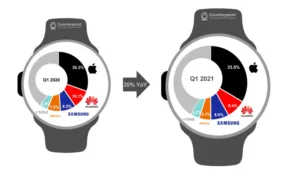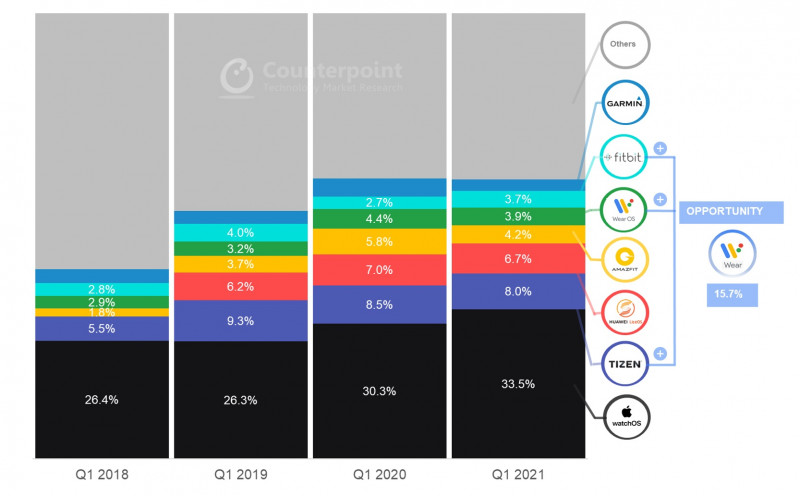Global smartwatch shipments in Q1 2021 grew 35% YoY, according to Counterpoint Research’s recently published Global Smartwatch Model Tracker. Apple maintained its leadership position, catalyzing the overall market growth by recording a 50% YoY increase in the demand for the new Series 6 models. As a result, Apple saw its market share climb by 3% points.
Samsung’s shipments also rose 27% YoY, with the popularity of the Galaxy Watch 3 and Galaxy Watch Active series. But the South Korean vendor’s growth was below the market average and it saw a small dip in its market share. Huawei continued to lose share compared to a strong quarter a year ago.
These volumes include basic smartwatches with low-level proprietary OS or RTOS (like from Xiaomi and OPPO), kids smartwatches (like from BBK, Huawei and Vodafone Neo) and high-level smartwatches (like from Apple, Samsung and Garmin).
Exhibit 1: Global Smartwatch Shipments Share, Q1 2021 vs. Q1 2020 (in %)
Senior Analyst Sujeong Lim said, “Apple was able to further solidify its leadership position in the market by widening the portfolio from Watch SE to Series 6 at the right time. This may drive Samsung to launch a mid-price-tier model to boost growth.”
Lim added “Huawei continued to face headwinds because of the declining smartwatch sales and how well Huawei watches are optimized for its smartphones. Will be interesting to see when Huawei launches its first watch based on Harmony OS, as it hinted at the Huawei Analyst Summit last month. This should kickstart a new ecosystem for developers to build experiences for the wrist. But it will warrant a Harmony OS phone as well for the complete experience. HONOR, spun off from Huawei, should open up new opportunities for players such as Google and Qualcomm.”
In terms of smartwatch OS platforms, Apple’s WatchOS captured more than a third of the market with a growing attach rate to its base of billion iPhone users. Google’s Wear OS has not yet achieved such success in smartwatches. This is because most of the major smartwatch brands have developed and installed their own proprietary OS (like Fitbit OS, Tizen and Garmin OS). Further, Wear OS has been lacking behind in terms of features, battery optimization and chipset support. This has limited its share to a mere 4% of the global smartwatch market.
Exhibit 2: Global Smartwatch Shipments Share by Operating System (in %)
However, this trend will change soon considering the Google-Samsung partnership announced at the Google I/O last week. Google will integrate Tizen OS with Google Wear OS to reinvigorate the market and go full force after the 3.5 billion Android user base.
Lim said, “Hopefully, Google’s new Wear platform will be shipping in the next generation of the Galaxy Watch series in late Fall. It will be good for the companies involved. The focus would be to not only improve performance, such as battery life, but also improve on the AI, newer apps and services, and integration with Android smartphones. Samsung will also be able to better target the broader Android smartphone user base. With the completion of the acquisition of Fitbit, Google should be able to enhance the Wear platform with ‘fitness’ capabilities and services integration, moving forward.”
Commenting further on the Google-Samsung announcement, Vice President Research Neil Shah said, “This is a great move by Google to accelerate its ambitions for the wearables space. It can build a robust portfolio of Wear devices integrating the best of all the three worlds – Tizen OS, Wear OS and Fitbit OS. The consolidation brings more power to Google’s Wear platform and will attract more developers to build newer experiences for the wrist.”
Highlighting why there is so much excitement for wrist wearables among tech companies, Shah said, “Wearable devices and services are going to become important for companies such as Apple, Google, Facebook and Amazon as they increasingly expand their reach in healthcare, pharmaceutical and insurance verticals directly or indirectly. This can include selling services such as Apple Fitness+, predictively cross-selling medicines and healthcare solutions, or attracting marketers to their ad platforms based on the health profiles built with the enormous amount of data generated via the number of sensors on these wearable devices. Further, addition of advanced voice AI and ML capabilities on these devices will make wrist as one of the key segments technology companies will go after this decade before adding eyes/brain-based advanced wearable devices to the mix.”


